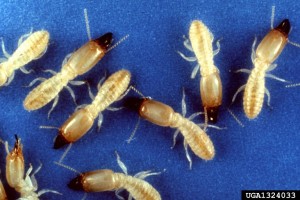Is Your Basement Termite-Proof?
By Chris Williams on May 11, 2015.

Eastern subterranean termite soldiers protect the colony
The basement or crawlspace in a home is often the starting point for a subterranean termite infestation. Why? The basement foundation is the one part of the house that is in contact with soil, a termite requirement.
Foundation Cracks Become Termite Highways
Termites live in soil and forage from there looking for available wood to feed on (see How Do Termites Find Wood?). Cracks in basement foundations provide little highways for foraging termites, leading them directly to wood members in your home. They will build mud tubes inside the cracks so that they are protected from drying out while they travel back and forth from soil to wood. The only basement totally protected from termites is one that is completely sealed, with no cracks—a rarity indeed. Because we keep basements warm in the winter, termites that have gained entry can remain active and continue feeding even when it’s very cold outside (see Do Termites Hibernate in Winter?).
Poured concrete foundations may be the most resistant to termites, if they have no cracks. Block and brick foundations tend to develop cracks as they age, allowing termite entry. Hollow blocks allow termites to travel virtually undetected. Slab construction is at high risk for termites since wood timbers are fairly close to the soil level. Crawlspaces usually have dirt floors and little ventilation, two conditions that termites like.
Finished basements are not immune to termite infestation either. In fact, it’s even harder to inspect and detect termites in a finished basement. Termites can be active behind finished walls or under finished floors that can be impossible to check without damage.
Foundation Pretreatments Offer Some Protection
All of this sounds pretty scary, but keep in mind that all home foundations must be pretreated for termites during the construction phase. If this step is done correctly, your home should be protected for many years from termites entering around the foundation. The problems occur later when the protective chemical is no longer active, or when something happens that allows termites to bypass the protective barrier and reach wood. That “something” can be cracks in the foundation, digging or landscaping that disturbs the soil barrier, or addition of wood elements like decks or porches that touch the home and also provide direct contact with the soil (see How Did Termites Get Into My House?).
If you’re worried about whether or not your basement is protected from termite infestation, give Colonial Pest a call. Our termite inspectors can look for evidence of termites and can check for conditions that might allow termite entry. If your home needs a new termite treatment, we can do that too.
Photo credit: USDA ARS Photo Unit, USDA Agricultural Research Service, Bugwood.org